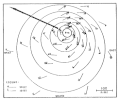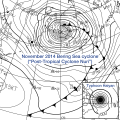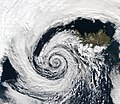
Back بوابة:الأعاصير المدارية Arabic Portal:Ciclons tropicals Catalan Portal:Ciclones tropicales Spanish 포털:태풍 Korean Portaal:Tropische cyclonen Dutch Portal:Ciclones tropicais Portuguese สถานีย่อย:พายุหมุนเขตร้อน Thai Portal:熱帶氣旋 Chinese
The Tropical Cyclones Portal

A tropical cyclone is a storm system characterized by a large low-pressure center, a closed low-level circulation and a spiral arrangement of numerous thunderstorms that produce strong winds and heavy rainfall. Tropical cyclones feed on the heat released when moist air rises, resulting in condensation of water vapor contained in the moist air. They are fueled by a different heat mechanism than other cyclonic windstorms such as Nor'easters, European windstorms and polar lows, leading to their classification as "warm core" storm systems. Most tropical cyclones originate in the doldrums, approximately ten degrees from the Equator.
The term "tropical" refers to both the geographic origin of these systems, which form almost exclusively in tropical regions of the globe, as well as to their formation in maritime tropical air masses. The term "cyclone" refers to such storms' cyclonic nature, with anticlockwise rotation in the Northern Hemisphere and clockwise rotation in the Southern Hemisphere. Depending on its location and intensity, a tropical cyclone may be referred to by names such as "hurricane", "typhoon", "tropical storm", "cyclonic storm", "tropical depression" or simply "cyclone".
Types of cyclone: 1. A "Typhoon" is a tropical cyclone located in the North-west Pacific Ocean which has the most cyclonic activity and storms occur year-round. 2. A "Hurricane" is also a tropical cyclone located at the North Atlantic Ocean or North-east Pacific Ocean which have an average storm activity and storms typically form between May 15 and November 30. 3. A "Cyclone" is a tropical cyclone that occurs in the South Pacific and Indian Oceans.
Selected named cyclone -
Very Intense Tropical Cyclone Freddy, also known as Severe Tropical Cyclone Freddy, was an exceptionally long-lived, powerful, and deadly tropical cyclone that traversed the southern Indian Ocean for more than five weeks in February and March 2023. Freddy was the longest-lasting tropical cyclone ever recorded worldwide, and produced the most accumulated cyclone energy—a metric used to measure the total energy generated by tropical cyclones—of any individual cyclone on record globally. Additionally, it is the third-deadliest tropical cyclone recorded in the Southern Hemisphere, only behind 2019's Cyclone Idai and the 1973 Flores cyclone.
Freddy originated from a tropical low that was located south of the Indonesian archipelago on 4 February 2023. As it traveled westward across the Indian Ocean, the storm quickly intensified, becoming a Category 4 severe tropical cyclone on the Australian scale. Freddy moved into the South-West Indian Ocean, where it reached its peak intensity with 10-minute sustained winds of 230 km/h (145 mph) and a central atmospheric pressure of 927 hPa (27.37 inHg), making it a very intense tropical cyclone. Meanwhile, 1-minute sustained winds reached 260 km/h (160 mph), corresponding to Category 5-equivalent intensity on the Saffir–Simpson scale. After reaching its peak intensity, the cyclone moved toward the northern Mascarene Islands and made landfall near Mananjary, Madagascar on 21 February. It weakened further across Madagascar but regained strength upon reaching the Mozambique Channel, where it intensified and made its second landfall near Vilankulos, Mozambique on 24 February. After moving across Mozambique, the cyclone endured and re-entered the channel on 1 March. It then regained its tropical characteristics and started moving along the coast of Madagascar. Freddy intensified again before making its final landfall near Quelimane, Mozambique on 11 March. It then rapidly weakened as it moved inland and dissipated by 14 March. (Full article...)
Selected article -
A tropical cyclone rainfall climatology is developed to determine rainfall characteristics of past tropical cyclones. A tropical cyclone rainfall climatology can be used to help forecast current or upcoming tropical cyclone impacts. The degree of a tropical cyclone rainfall impact depends upon speed of movement, storm size, and degree of vertical wind shear. One of the most significant threats from tropical cyclones is heavy rainfall. Large, slow moving, and non-sheared tropical cyclones produce the heaviest rains. The intensity of a tropical cyclone appears to have little bearing on its potential for rainfall over land, but satellite measurements over the last several years show that more intense tropical cyclones produce noticeably more rainfall over water. Flooding from tropical cyclones remains a significant cause of fatalities, particularly in low-lying areas. (Full article...)
Selected image -

Selected season -
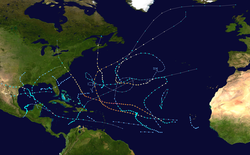
The 2003 Atlantic hurricane season was a very active season with tropical cyclogenesis occurring before and after the official bounds of the season—the first such occurrence since the 1970 season. The season produced 21 tropical cyclones, of which 16 developed into named storms; seven of those attained hurricane status, of which three reached major hurricane status. The strongest hurricane of the season was Hurricane Isabel, which reached Category 5 status on the Saffir–Simpson hurricane scale northeast of the Lesser Antilles; Isabel later struck North Carolina as a Category 2 hurricane, causing $3.6 billion in damage (2003 USD) and a total of 51 deaths across the Mid-Atlantic region of the United States.
Although the bounds of the season are typically from June 1 to November 30, the season began early with the formation of Subtropical Storm Ana on April 20, and it ended relatively late on December 11 with the dissipation of Tropical Storm Peter. In early September, Hurricane Fabian struck Bermuda as a Category 3 hurricane, where it was the worst hurricane since 1926; on the island it caused four deaths and $300 million in damage (2003 USD). Hurricane Juan caused considerable destruction to Nova Scotia, particularly Halifax, as a Category 2 hurricane, the first hurricane of significant strength to hit the province since 1893. Additionally, Hurricanes Claudette and Erika struck Texas and Mexico, respectively, as minimal hurricanes. In December, Tropical Storm Odette struck the Dominican Republic, and Tropical Storm Peter formed in the eastern portion of the basin. (Full article...)
Related portals
Currently active tropical cyclones
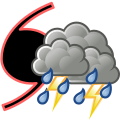
Italicized basins are unofficial.
- North Atlantic (2025)
- No active systems
- East and Central Pacific (2025)
- No active systems
- West Pacific (2025)
- No active systems
- North Indian Ocean (2025)
- No active systems
- Mediterranean (2024–25)
- No active systems
- South-West Indian Ocean (2024–25)
- No active systems
- South Pacific (2024–25)
- No active systems
- South Atlantic (2024–25)
- No active systems
Last updated: 12:38, 11 May 2025 (UTC)
Tropical cyclone anniversaries

- May 13, 2001 - Tropical Storm Cimaron (pictured) reached its peak intensity with 110 km/h (70 mph) winds shortly before it struck the Okinawa Islands, bringing heavy rain.

May 14
- 1997 - Cyclone Rhonda reached its peak intensity in the open Indian Ocean with winds of 185 km/h (115 mph).
- 2007 - Cyclone Akash (pictured) damages a total of US$982 million over in Bangladesh and Burma, also killing a total of 14.
- 2020 - Typhoon Vongfong makes landfall over Visayas, Philippines as a Category 3 typhoon.

May 15
- 1996 - Typhoon Bart reaches Category 4 typhoon intensity just northeast of Luzon.
- 2023 - Cyclone Mocha (pictured) hit Myanmar, killing 463 people and leaving $2.24 billion in damage.
- 2025 - The 2025 East Pacific hurricane season officially begins.
Did you know…




- …that the Joint Typhoon Warning Center considers that Typhoon Vera (pictured) of 1986 is actually two distinct systems, formed from two separated low-level circulations?
- …that Cyclone Freddy (track pictured) in 2023 was the longest-lasting tropical cyclone recorded?
- …that the typhoons of 2024—Yinxing, Toraji, Usagi, and Man-yi (pictured)—made history as the first recorded instance since 1951 of four tropical cyclones coexisting in November?
- …that Hurricane Otis (pictured) in 2023 was the first Pacific hurricane to make landfall at Category 5 intensity and surpassed Hurricane Patricia as the strongest landfalling Pacific hurricane on record?
General images -

The 2012 Atlantic hurricane season was an event in the annual hurricane season in the north Atlantic Ocean. For the third year in a row there were 19 named storms. The season officially began on June 1, 2012, and ended on November 30, 2012, dates that conventionally delimit the period of each year when most tropical cyclones develop in the Atlantic basin. Surprisingly, two preseason storms formed: Alberto on May 19, and Beryl on May 26. This was the first such occurrence since the 1951 season. The final storm to dissipate (second-to-last to become a named storm) was Sandy, on October 29. Altogether, ten storms became hurricanes, of which two intensified into major hurricanes.
Storm impact during the season was widespread and ruinous, with the most significant storms in term of loss of life and damage being hurricanes Isaac and Sandy. A Category 1 on the Saffir–Simpson hurricane wind scale, Isaac was a large system that moved ashore the coast of Louisiana on August 12; the storm resulted in 41 deaths overall. Sandy, the second and final major hurricane of the season, was the largest Atlantic hurricane ever recorded, with a wind diameter of more than 1,100 mi (1,800 km). The system moved ashore the southern coast of New Jersey as an extratropical cyclone in late October. During its duration as a tropical cyclone, Sandy caused at least $68 billion (2012 USD) in damage and 285 fatalities. Sandy is the second-costliest Atlantic hurricane in recorded history, surpassed only by Hurricane Katrina during the 2005 season. (Full article...)
Topics
Subcategories
Related WikiProjects
WikiProject Tropical cyclones is the central point of coordination for Wikipedia's coverage of tropical cyclones. Feel free to help!
WikiProject Weather is the main center point of coordination for Wikipedia's coverage of meteorology in general, and the parent project of WikiProject Tropical cyclones. Three other branches of WikiProject Weather in particular share significant overlaps with WikiProject Tropical cyclones:
- The Non-tropical storms task force coordinates most of Wikipedia's coverage on extratropical cyclones, which tropical cyclones often transition into near the end of their lifespan.
- The Floods task force takes on the scope of flooding events all over the world, with rainfall from tropical cyclones a significant factor in many of them.
- WikiProject Severe weather documents the effects of extreme weather such as tornadoes, which landfalling tropical cyclones can produce.
Things you can do
 |
Here are some tasks awaiting attention:
|
Wikimedia
The following Wikimedia Foundation sister projects provide more on this subject:
-
Commons
Free media repository -
Wikibooks
Free textbooks and manuals -
Wikidata
Free knowledge base -
Wikinews
Free-content news -
Wikiquote
Collection of quotations -
Wikisource
Free-content library -
Wikiversity
Free learning tools -
Wikivoyage
Free travel guide -
Wiktionary
Dictionary and thesaurus
© MMXXIII Rich X Search. We shall prevail. All rights reserved. Rich X Search

